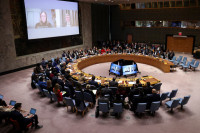Opinion
Stop child labour
We can make a difference by refusing to buy products made using child labour
David Kainee
One morning last week, while I was having breakfast at a roadside hotel, I heard the owner unleashing a volley of foul language at a child who was working as a waiter. His only mistake was that he couldn’t serve tea on time to a customer. Such mental harassment against an innocent child by the hotelier infuriated me. In my fury, I decided not to eat at that hotel again until the hotelier replaced all the children working as waiters with adults.
Global problem
Even though the constitution prohibits using children in any form of labour, millions of child labourers are working across the country in various sectors. Today, children are engaged in farming, herding cattle, producing bricks, mining, breaking stones, building homes, weaving carpets and making embroidered textiles. Kids are also employed in hotels, transportation, circuses, night clubs and dance bars besides being used in pornography and child prostitution. Even though the Child Labour (Prohibition and Regulation) Act prohibits engaging a child who has not completed 14 years of age in any kind of employment, one in every 20 households in the capital city Kathmandu itself has a child working as domestic help, according to a report entitled ‘Status of Domestic Child Labour in Kathmandu Valley’ published by an NGO working in the sector of child rights.
According to the findings of the Multiple Indicator Cluster Surveys (MICS) and other national studies, 34 percent of the children between the ages of five and 14 are involved in child labour compared with 12 percent in the South Asia region. Likewise, Nepal Labour Force Survey 2008 has revealed that 3.14 million children between the ages of five and 17 are working as child labourers across the country. Another study carried out in 2012 by World Education Nepal and Plan International showed that there were 13,715 child labourers working in brick factories in the Kathmandu Valley alone.
The International Labour Organisation (ILO) has defined child labour as work that deprives children of their childhood, education, potential and dignity and work that is harmful to their physical and mental development. Kailash Satyarthi, founder of Bachpan Bachao Andolan and a Nobel Peace Laureate, says, “A childhood without education isn’t a childhood at all, and every youth who is out of school is one too many.” It is disheartening to see millions of children being robbed of their rights by being forcefully engaged in hazardous work in the country. If children are sent to school, every additional year of schooling a young person receives increases their average future earnings by 10 percent besides boosting a country’s average annual GDP growth by 0.37 percent, according to Unesco.
Child labour is a global problem as millions of children are being denied quality education. There are 263 million children out of school worldwide, including 63 million in conflict zones and another 30 million with disabilities. The government of Nepal has ratified ILO Convention No 138 which states that children may do 14 hours of work per week provided that it doesn’t intervene with compulsory school and does not harm the child’s health and development.
Root causes
Even though the promulgation of Child Labour Act 1992 and the ratification of ILO Convention Nos 138 and 182 have been major stepping stones in addressing the precarious problem of child labour, it is unfortunate that children are still working as bonded slaves in many parts of the country. This is happening in the name of Kamlahari even though the government had freed them some years ago. The constitution too has outlawed child labour, and persons found forcing children up to 16 years old to work faces a maximum jail term of one year and a fine of Rs50,000.
When Nepal has ratified international conventions and made laws to abolish child labour, how are millions of kids still being forced to work? Poor implementation of the law and lack of awareness among the general people could be the answer. In Nepal’s case, the roots of the problem of child labour lie deep in the larger socio-economic and cultural system of the country. Eradicating child labour demands serious efforts to reduce widespread poverty. When parents are struggling to provide two square meals daily to their children, they are forced to send them to work. Focusing only on banning child labour without taking the livelihood options of poor families into account will not solve the prevalent problems of child labour.
Similarly, the social acceptability of child labour is a cause for worry. When educated people and advocates of children’s rights are keeping child labourers in their own homes, it is impossible to eradicate the problem of child labour. Engaging children in work forcefully is a heinous crime. Therefore, we as educated citizens of the 21st century shouldn’t allow child labour in the services we employ. When we as consumers take a stand by refusing to buy products which have been made by using child labour, it can be a significant step in the fight against the problem in the country.
Kainee is associated with Global Hope Network International




 5.47°C Kathmandu
5.47°C Kathmandu












